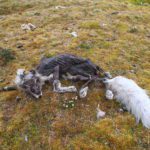Arctic fox
The cunning bi-colored hunter
The Arctic fox, also known as the white fox, polar fox, or snow fox, is a small-sized fox native to and common throughout the Arctic. It is well adapted to living in cold environments
Regulations
Regulations It is a violation of Svalbard’s Environmental Protection Act’s general principle of protection to disturb foxes. According to the act, “All species of flora and fauna, including their eggs, nests and lairs, are protected …” and “all access and passage in Svalbard shall take place in a way that does not harm […] or in any other way […] result in unnecessary disturbance of animals.” (Section 25 and 73 of Act of 15 June 2001 No.79 Relating to the Protection of the Environment in Svalbard)
In other regions of the Arctic national and local regulations may include other or different provisions. Always check and abide by the legal requirements in the area you are visiting.
Watching undisturbed wildlife in its natural environment is a great experience. To avoid disturbance when close to Arctic fox, you are asked to be considerate and follow these wildlife guidelines.
Guidelines
- Arctic foxes may be inquisitive. Stay quiet and let the animals approach you and not vice versa.
- Foxes that live near settlements, cabins and camps grow accustomed to humans, and if they are fed, they gradually lose their natural fear. Never feed or attempt to touch Arctic foxes.
- Limit your time in proximity around foxes to avoid unnecessary habituation.
- Do not intentionally walk into areas with fox dens between June and mid-August. If you accidentally find yourself in a foxhole area, retreat quietly the way you came.
- Keep distance to known fox dens, if possible 500 – 1,000 meters depending on the terrain. Dens are often located near the shore, close to bird cliffs.
- Female foxes can give birth to large litters of pups. Sometimes more than 10. If fox pups approach you, leave them alone.
- Rabies has been detected in Arctic regions. Some animals, such as the arctic fox, arctic dogs and arctic wolves are potential carriers of rabies. Close contact to arctic foxes is potentially dangerous because of rabies. Fox bites can be dangerous to humans. Never touch live or dead wild animals. Inform local authorities if you observe dead animals or animals that might carry the rabies virus.
Signs of disturbance
To avoid unnecessary disturbance of foxes, observe the animal’s behavior. If foxes show signs of disturbance, retreat quietly the way you came. If a fox is barking, yelping, or warning its pups, you might be too close. Other visual signs of disturbance can be the flattening of ears, a tail pointed upwards, or behavior suggesting the fox is attempting to flee. An Arctic fox will protect its den and its pups, and during the denning time foxes are most sensitive to disturbance.




